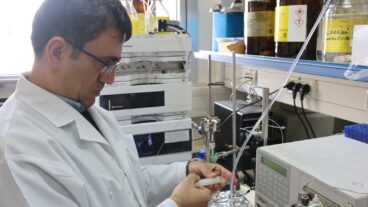Hair can be used to diagnose stress levels, drug intake, and even your risks of a heart attack, according to new Israeli research.

Long or short, styled or shaggy, you can tell a lot about people by the way they wear their hair. It provides clues to how they see themselves, and how they hope to be perceived. And according to several important studies by Israeli-Canadian researcher Dr. Gideon Koren, your hair can also reveal lifestyle information, such as whether you have been under stress and are at greater risk of a heart attack.
If you know what to look for, says the professor of pediatric medicine and toxicology at the University of Western Ontario, hair can tell you what a person has been up to.
Indeed, Koren’s research has helped to divulge secrets hidden in hair; specifically, the level of stress a person has had to contend with. Following a study by a colleague of his about a decade ago that showed that cortisol (also known as hydrocortisone, a steroid hormone or glucocorticoid), produced by the adrenal gland, is present in human hair, Koren decided to study the relationship between cortisol levels and levels of stress.
“As cortisol is a known biomarker for stress, and because hair grows about a centimeter [0.4 inch] a month, I thought this was a great opportunity to measure chronic stress over time,” he tells ISRAEL21c, adding that his research has led to a new biological marker that “can be used to help prevent heart attacks.”
Building your “stress record” through your hair
While hair itself consists of dead cells, a hair’s follicle – which contains its roots – is alive, and substances in the bloodstream, like cortisol, can leech into the follicles from blood vessels in the scalp. As hair grows, the cortisol moves up the strand. Taking into consideration the rate of hair growth per month Koren says, you can determine how much stress an individual has been under in recent months.
In fact, it turns out that the cortisol count in hair is the most reliable measure of the hormone to be found by scientists to date. Previously they had to rely on measures of cortisol in blood or urine, which record only a few hours’ or days’ worth of the hormone. Thus, depending on hair length, a doctor could determine how much stress a person has been under for the preceding six months or even more, and whether or not those stress levels have increased recently.
In a study in 2008 and 2009, Koren tested the theory at Meir Hospital in Kfar Saba, where he took hair samples from 120 men with a history of either heart attacks or chest pain and infections. Men were the only candidates in the first of what Koren hopes will be several studies, since they are more likely to have experienced heart-related stress.
Members of the research team analyzed the 1.2 inches of hair closest to the scalp, and using the cortisone level measurements they built a “stress record” covering the previous three months for the subjects in the study.
Cocaine used by mothers found in infants’ hair
The study confirmed Koren’s theories. Subjects who had experienced a heart attack showed significantly higher levels of cortisol in their hair. All the men in the study showed higher than average cortisol levels; about one third of the men with the lowest levels had experienced heart attacks, while heart attacks were experienced by more than two thirds of those with the highest levels of cortisol in their hair.
Koren, who was born in Tel Aviv, says he has conducted numerous studies at Meir Hospital with collaborator Prof. Michael Lishner. In a new study at the hospital that also involves cortisone measurement levels, Koren is examining the effects of stress on in-vitro fertilization candidates.
The current studies are not Koren’s first that involve hair. “My laboratory has long been interested in the way drugs and alcohol are incorporated into hair. In 1988 I published the first paper showing that when a mother used cocaine in late-stage pregnancy, elements of the drug are incorporated into the baby’s hair. We later determined that almost every drug taken by the mother can be found in the baby. This study led to significant breakthroughs in enabling physicians to determine what a baby has been exposed to,” Koren recounts, adding that the technique is now used in hospitals on a regular basis.
A musical medical professor
Currently professor of Pediatrics, Pharmacology, Pharmacy and Medical Genetics at the University of Toronto, and professor of Medicine, Pediatrics, and Physiology-Pharmacology at the Schulich School of Medicine of the University of Western Ontario, Koren is also director of Toronto Hospital for Sick Children’s Motherisk Program, which he founded in 1985. Educated at Tel Aviv University, he spends about three months a year in Israel, working on his research and visiting relatives.
In addition to making his mark in the medical world, Koren also had a career as an Israeli singing star. “I wrote music for Shlomo Artzi, Yigal Bashan, and many other top Israeli performers. Between 1974 and 1980 my songs won the Israel Song Festival four times, and the Children’s Song Festival twice. In 1971, I created the singing group ‘The Brother and the Sisters,’ which was the leading folk-pop band in Israel until 1982, when we broke up. In 2004, the band reunited, and I’ve been writing new music for them.”
Now Koren has found a way to combine his passions: “I created a musical theater for hospitalized kids that has been performing a therapeutic play called ‘Tails’ weekly at Toronto hospitals since 1992. We are now at 900 plays and still counting,” he says. The professor intends to continue studying the connection between stress and hair. After all, it could save lives, he concludes.












